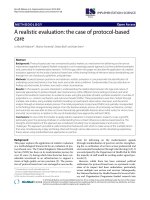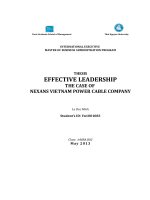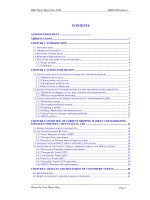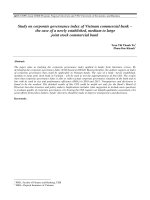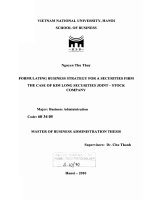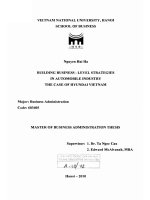Building a learning organization the case of logigear vietnam
Bạn đang xem bản rút gọn của tài liệu. Xem và tải ngay bản đầy đủ của tài liệu tại đây (1.98 MB, 92 trang )
BỘ GIÁO DỤC VÀ ĐÀO TẠO
TRƯỜNG ĐẠI HỌC KINH TẾ TP. HỒ CHÍ MINH
----- oo0oo -----------------
VƯƠNG BẢO LONG
BUILDING A LEARNING ORGANIZATION
– THE CASE OF LOGIGEAR VIETNAM
LUẬN VĂN THẠC SĨ KINH TẾ
TP. HỒ CHÍ MINH – NĂM 2017
BỘ GIÁO DỤC VÀ ĐÀO TẠO
TRƯỜNG ĐẠI HỌC KINH TẾ TP. HỒ CHÍ MINH
----- oo0oo -----
VƯƠNG BẢO LONG
BUILDING A LEARNING ORGANIZATION
- THE CASE OF LOGIGEAR VIETNAM
Chuyên ngành: Quản trị kinh doanh (eMBA)
Mã số:
60 34 01 02
LUẬN VĂN THẠC SĨ KINH TẾ
Người hướng dẫn khoa học: TS. Lý Thị Minh Châu
TP. HỒ CHÍ MINH – NĂM 2017
STATEMENT OF AUTHENTICATION
I hereby declare that the work presented in this thesis is, to the best of my
knowledge and belief, original. The ideas and quotes taken from external sources
are duly acknowledged in the text. The material, either in full or in part, has not
been previously submitted to any other institution.
Ho Chi Minh City, March 31, 2017
(signed)
Vuong Bao Long
Table of Contents
Secondary Cover Page
Statement of Authentication
Table of Content
Table of Figures
List of Tables
Abstract ............................................................................................................................................. 1
Chapter I - INTRODUCTION .......................................................................................................... 2
1.1 Rationale .................................................................................................................................. 2
1.2 Problem Statement ................................................................................................................... 6
1.3 Research Questions ................................................................................................................ 10
1.4 Research Objectives ............................................................................................................... 10
1.5 About LogiGear ..................................................................................................................... 11
Chapter II - LITERATURE REVIEW ............................................................................................ 14
2.1 What is “Learning”?............................................................................................................... 14
2.2 What is a “Learning Organization”? ...................................................................................... 17
2.3 Knowledge and Knowledge Management ............................................................................. 23
2.4 Innovation and Innovation Competence ................................................................................ 25
Chapter III - RESEARCH METHODOLOGY ............................................................................... 30
3.1 Data Collection ...................................................................................................................... 32
3.2 Participants in Interviews - Key Stakeholder Groups ............................................................ 32
3.3 Data Analysis ......................................................................................................................... 38
3.4 Research Model...................................................................................................................... 41
Chapter IV - FINDINGS & DISCUSSIONS .................................................................................. 42
4.1 Personal Mastery .................................................................................................................... 43
4.2 Mental Models ....................................................................................................................... 46
4.3 Shared Vision ......................................................................................................................... 47
4.4 Team Learning ....................................................................................................................... 49
4.5 Systems Thinking................................................................................................................... 52
4.6 Technology............................................................................................................................. 56
4.7 Summary of Findings & Discussions..................................................................................... 60
4.8 Framework Suggestion .......................................................................................................... 63
Chapter V - CONCLUDING REMARKS ...................................................................................... 74
References
Appendices
Table of Figures
Figure 1.1- Scope of Research .............................................................................................. 6
Figure21.2- Transforming to a Learning Organization ....................................................... 10
Figure31.3- TestArchitect, the automation test tool of LogiGear ........................................ 12
Figure42.1- Single-Loop Learning and Double-Loop Learning ......................................... 15
Figure52.2- Triple-loop learning by Asian Development Bank .......................................... 15
Figure62.3- Kolb's Experiential Learning Style .................................................................. 16
Figure72.4- Three-leg Model for Learning Organization .................................................... 19
Figure82.5- Overall model of a learning organization ........................................................ 20
Figure92.6- A Framework for Understanding Tacit Knowing ............................................ 24
Figure103.1- Description of data collection and data analysis ............................................ 40
Figure103.2- Research Model: Elements That Construct Learning Organization .............. 41
Figure114.1- Sarder’s Principle: Two Percent of Revenue to Learning and Development 55
Figure124.2- Framework for Building “Learning Organization” for LogiGear VN ........... 64
Figure134.3- Org. Chart of the "Learning Organization" Task Force ................................. 72
Figure144.4- The Action Plan to Build A “Learning Organization” ................................... 73
List of Tables
Table11.1- Diagnosis Report of LogiGear’s Learning Culture ............................................. 9
Table21.2- Ranges of Services by LogiGear VN ................................................................ 12
Table33.1- Five Disciplines by Peter Senge ........................................................................ 31
Table43.2- Data Collection - Interview Coding & Demographics ...................................... 35
Table53.3- Data Collection - Focus Group Coding & Demographics ................................ 37
Table64.1- Factors that construct Learning Organization in LogiGear ............................... 61
Table74.2- Qualtrics for Learning Organization ................................................................. 71
1
BUILDING A LEARNING ORGANIZATION
– THE CASE OF LOGIGEAR VIETNAM
Abstract
This research is to find the factors that contruct a “learning organization” for
LogiGear Vietnam, an information technology company. In the backdrop of the
Five-Discipline Model of “Learning Organization” by Perter Senge, the author
employed a qualitative method to collect and analyze data from in-depth interviews
and focus group with all three levels of staff in the company, being software
engineers, middle layer managers, and top executives. The result revealed that
Senge’s five disciplines (Personal Mastery, Mental Minsets, Shared Vision, Team
Learning, Systems Thinking) do exist in LogiGear VN together with the 6th
discipline, “Technology”, found as an emergent finding. The research is specific,
designed and carried out in order to explore and suggest a model to build a
“Learning Organization”, the case of LogiGear Vietnam.
Keywords: learning, knowledge, learning organization, innovation, information
technology, LogiGear Vietnam.
2
“The ability to learn faster than your competitors may be
the only sustainable competitive advantage.”
- Arie P. De Geus
Head of Planning for the Royal Dutch/Shell Group of Companies
Chapter I - INTRODUCTION
1.1 Rationale
LogiGear VN is an information technology company, specialized in software
testing and software development. Doing business in a fast changing, fast
developing industry where technological change takes place almost every minute, it
has no other way than to become most adaptive to change and most innovative in
providing solutions and services to customers in order to succeed. Learning from
success stories from tech giants Apple, Google, Amazon, Netflix, etc. the board of
management of LogiGear VN found out that innovation is the key. And, innovation
should not be expected from a single genius, happening over night, or appreaing in
an “aha!” moment, but it’s “a result from hard and focused work” (Drucker, 2015).
Nowadays, “innovation discipline is still in its infancy, but competencies that
increase chances of innovation can now be learned.” (Bezerra, 2005)
The Fourth Industrial Revolution (4IR) - of which the emerging technology
breakthroughs in fields such as AI, IoT, robotics, 3D printing, and nano technology
prevail - urges companies to learn faster, produce faster and deliver faster using new
technologies that are merging the physical, digital and biological worlds (Schwab,
2016). LogiGear VN is not an exception and cannot be staying out of the circle of
influence, when it is an IT/software company with goal to be leading in its industry,
software testing and development. In order to pursue the vision and achieve its
strategic goal to become a transformational organization, LogiGear VN needs to be
innovative first hand and deep down it must become a “learning organization”.
3
In a seminar on innovation leadership in Ho Chi Minh City in 2013, Prof. Tony
Wagner of Harvard Business School articulated that if labor was a commodity in
the industrial age and knowledge was a valuable asset, it is now innovation that
creates quantum added value that ensures competitive advantage for sustainable
growth and development. He said, the imperative was true not only at corporate
level like the cases of IBM, Intel, Apple, Google, etc., but also at state level such as
Israel, Sweden, Switzerland, Norway, USA, Japan, etc.
Not long ago, World Bank and Ministry of Planning & Investment of Vietnam have
stressed that “boosting the learning and innovation in order to maintain a high and
sustainable growth needs a radical reform program.” (WB & MPI, 2016)
For a country to thrive, enhancing productivity using innovation competence is the
ultimate solution (Porter, 1990). For firms, innovation competence increases their
competitive advantage (Tidd & Bessant, 2015).
Nguyen Van Dung and colleagues (2016) emphasize the importance of innovation
in a knowledge economy. They examine the role of different components of
knowledge economy in economic growth and other factors such as innovation,
education, etc. that simultaneously affect economic growth of 37 countries in Asia
during 1990 – 2014. The research confirms that “there exists a positive association
between economic growth and four components of the knowledge economy
framework”, which are innovation, education, ICT infrastructure, and natural
resources intensity.
Nadeshwar and Jayasimha (2010, p. 182) wrote “while all people have the capacity
to learn, the structures in which they have to function are often not conducive to
reflection and engagement. Furthermore, people may lack the tools and guiding
ideas to make sense of the situations they face”. As to Senge, for a learning
organization, ‘adaptive learning’ must be joined by ‘generative learning’ and
double-loop learning that enhances our capacity to create.” (Senge, 1990, p. 13-14)
4
Indeed, to compete and win in the context of increasing globalization, integration,
and rapidly evolving technologies, individuals and organizations have no way other
than building their ability to learn – the cornerstone for continuous improvement,
operational excellence, and innovation. Hess agreed that “companies that learn
fastest and adapt well to changing environments perform the best over time.” (Hess,
2014)
Bersin (2012) quoted in his article “5 Keys to Building a Learning Organization”
that the worldwide corporate training industry valued at 135 billion US dollars, but
“companies now realize that they simply cannot find the skills they need in the
workforce and have to reinvest heavily in corporate training… Should companies
go back to the 1980s and build a corporate university again? The answer is
no. Today the world of corporate training has been revolutionized.” (Bersin, 2012)
He suggested 5 keys to build a learning organization, which are: (1) corporate
learning is "informal" and HR doesn't own it, (2) Promote and reward expertise, (3)
Unleash the power of experts, (4) Demonstrate the value of formal training, and (5)
Allow people to make mistakes. He believed “The best organizational learning (and
individual learning) occurs right after you make a huge mistake.” And most
interestingly was his recent assertion on Forbes.com March 09, 2017 of AI1 and
cognitive computing that change the way corporate people learn: “Thirty-eight
percent of companies in our new research (10,400 respondents from 140 countries)
believe that robotics and automation will be "fully implemented" in their company
within five years” (Bersin, 2017). Although there would be a long way for robotics
to fully replace men in learning, the possibility it comes true is not petite.
Innovative organization should start from being a learning organization. This means
a simultaneous visionary transformation and involves all levels of resources
(individual, team, and organization itself) along the process of the organization’s
development. (Senge, 1990)
1
AI – Artificial Intelligence
5
As an information technology company, LogiGear’s workforce comprises of 99%
knowledge workers who are software engineers, a kind of “knowledge workers”
whose main capital is knowledge and whose job is to "think for a living"
(Davenport, 2005). Crabtree et al. (1997) reveals that knowledge workers spend
38% of their time searching for information. Loo (2017) suggests a definition of
creative knowledge work from four specific roles: copywriting, creative directing,
software programming, and systems programme managing in advertising and IT
software. He finds out “Creative knowledge workers use a combination of creative
applications to perform their functions/roles in the knowledge economy including
anticipatory imagination, problem solving, problem seeking, and generating ideas
and aesthetic sensibilities” (Loo, 2017, p. 138). LogiGear VN values continual
learning and endlessly encourages employees to learn for good, individually and
collectively.
Down to earth, in the kick-off meeting in early January 2017, the CEO of LogiGear
VN restated and committed to make LogiGear VN “a transformation through
innovation”. Knowing that in order to reach the fame of innovation, which is
believed the concrete foundation for shifting it to new heights, LogiGear VN has to
first of all be a learning organization.
A great advantage for LogiGear VN is that their top executive leaders strongly
support learning. They are typical examples of people who regard on-going learning
and researching as a lifetime aspiration. They are frequent speakers in seminars,
conferences, forums of information technology around the world. They are
authors/editors who have books published internationally, some of which are bestselling books in their field.
LogiGear VN sets to gain an organizational transformation in 2018. A
transformation that best satisfies its customers, creates an innovative/self-driven
workforce, and accommodates for a sustainable business development. In order to
ensure the success of such a transformational shift, the company acknowledges it
6
has a multiple agenda to proceed. This research focuses on the block of “learning
organization” (Fig. 1.1).
Process
- Personal mastery
- Mental models
- Shared vision
- Team learning
- Systems thinking
Learning
Organization
Innovation
Transformation
- Customers’ satisfaction
- Innovative, self-driven
workforce
- Sustainable business
growth
Knowledge
Management
Figure 1.1- Scope of Research
Source: Adapted from Tidd and Bessant (2015), Rothwell (1992), Senge (1990, 2006), Schumpeter
(1934, 1939, 1942)
1.2 Problem Statement
Since 2015, triggered by market demands (agile deliverables, more cost effective,
better quality), technologies (shorter product life-cycles, new framework and
methodologies, etc), and internal dynamics such as optimizing workforce, business
re-model, corporate portfolio shift (Worley & Cummings, 2009), LogiGear VN has
been facing the demand for a transformational change. Although LogiGear VN sets
and carries out its mission “to provide leading-edge software testing technologies
and expertise to customers” (LogiGearVN, 2016), it could hardly compete with
other rivals in the industry. The number of sales closed has dropped significantly in
recent years; customers have been lately leaving for other providers who could offer
more advanced technological solutions (faster speed, higher performance, lower
price). The new capabilities of workforce are not improved up to the speed of new
changes in technology and customers’ demands. Since its commencement in 2005,
there were innovative improvements in methodologies, frameworks, processes, and
7
some initiatives, but all were carried out in such a small scale that was not sufficient
enough to generate radical transformation in LogiGear VN. The company filed and
got registered patent for TestArchitect®, an automation testing tool; and the
ABT®2, a methodology in software test automation, but those were just two single
cases.
Technology rapid change requires every tech company to fast adapt with it and to
be ahead of trends. Taking “cloud” trend for example, LogiGear VN has been remodelling its business, which is able to switch from the PC, local-based software
testing to cloud-based software testing and cloud-service-delivery. In order to
accommodate for this transformation, the engineers’ job role and skill sets are
required to be changed. They are more deeply and globally connected to the “cloud”
world and interacting together in real time. If they work on projects that employ
AWS or IBM cloud server/service, they should be first of all qualified by Amazon
and IBM for a various range of professional certificates.
Figure21.2- Technology Changes Job Role/Skill
Source: LogiGear VN’s training materials
2
ABT – Action-based Testing
8
Recent diagnoses on Dec 31, 2016 and June 30, 2016 using Harvard’s tool los.hbs.edu show that there is a serious problem in exercising “learning culture” of
the company. The survey tool is a questionnaire by Harvard Business School,
including 10 criteria designated into 3 groups. In particular, the surveyed result
shows 7/10 elements of “learning organization” fall below average score and tend to
significantly decline:
Psychological Safety: They remain unchanged 62.9 and 62.9 in the latest two
surveys, and lower than median score, 76.
Appreciation of differences: remain unchanged 57.1 and 57.1, and lower than
median score, 64.
Openness to New Ideas: although increased double in the recent survey from 32.1
(Jun 30, 2016) to 64.3 (Dec 31, 2016), but it is very much lower than median score,
90. There is improvement but still a long way to go to innovation.
Time for Reflection: 65.7 and 42.9 respectively. It is not very much far below the
median, 50, but there was a significant drop that the management should closely
look into.
Analysis: 60.0 and 54.3, pretty low compared to 71 median. There is almost no
debate, argument, feedback, active and multi-aspect communication. Learning
organizations really fear of “no conflict” and disagreement. They fear of no
feedback and idea.
Education and Training: not very much lower than median, 80; but dropped from
78.6 to 71.4. This is alarming.
Leadership that reinforces learning: 40.0 and 47.5, significantly low compared to 74
as median. This is a serious issue that needs to be urgently addressed, whether it is
the mindset or competence, at the manager or leader level.
Postively, there are three elements that stand higher than average level:
9
Experimentation: Increased from 57.9 to 82.1, an extreme jump over the median, 71.
Information Collection: Increased from 60.5 to 81.0, a significant jump over the
median, 80.
Information Transfer: Increased from 57.1 to 75.0, a little higher than median, 71.
The 7 declining elements seriously impact to the value of “learning organization”. It
releases a strong warning siren that the board of directors of LogiGear VN needs to
immediately take action to address the nearly happening catastrophe before being
late.
Table11.1- Diagnosis Report of LogiGear’s Learning Culture
Source: Garvin et al. (2008)
Furthermore, software technology is changing fast and LogiGear VN should not be
left behind. It needs to be technologically staying abreast of trends. The other
challenge is to find more innovative ways to create “blue oceans” (Kim &
Mauborgne, 2005) in order to lead and win. Acknowledging the reality and
10
perceiving that innovation is the key for building competitive advantage which
guarantees a flourishing existence and sustainable business development, the
company set high priority to transform itself to learning organization.
Current Organization
(Job description driven)
Learning Organization
(Personal mastery, mental models, shared
vision, team learning, systems thinking)
Figure21.2- Transforming to a Learning Organization
Source: Dull (2016)
1.3 Research Questions
What are the key elements that construct a learning organization, specifically for the
case of LogiGear VN? And;
What framework can be deployed to build LogiGear VN a learning organization?
1.4 Research Objectives
The research focuses on exploring key elements that construct the learning
organization, the case LogiGear VN, an information technology company; and
suggests a framework to build LogiGear VN a learning organization.
11
1.5 About LogiGear
Establishment
LogiGear Corp. (www.logigear.com) was founded in the Silicon Valley in 1994 by
top thought leaders in the software testing industry. Since then it has completed
software testing and development projects for prominent companies across a broad
range of industries and technologies. The headquarter continues to be in Silicon
Valley, California with a majority of the software testing and software development
staff based in Ho Chi Minh City and Da Nang, Vietnam, established 2004 as
“LogiGear VN”. The total headcounts of LogiGear VN is 500 as at the end of 2016.
LogiGear Corp. continues to grow as companies realize the benefits of outsourcing
their software testing and development. It is honored by Inc. 500|5000 as one the
fastest growing private companies in the USA in 2009, 2012, 2013, 2014.
Vision and Mission
LogiGear VN aims at becoming the world leading software testing and
development service provider. The company “provides leading-edge software
testing technologies and expertise, along with software development services that
enable our customers to accelerate business growth while having confidence in the
software they deliver.” (LogiGear VN’s website www.logigear.com)
Products and Services
Products
LogiGear VN’s product is the test automation tool named TestArchitect®. It is an
ideal test automation solution for high-volume test automation production. It lets
you quickly develop a large volume of easy to maintain automated tests—using the
tool’s built-in actions that eliminate coding.
12
Figure31.3- TestArchitect, the automation test tool of LogiGear
Source: LogiGear’s website (www.logigear.com)
A single, plain text, action-based test replaces multiple lines of code, which speeds
testing and makes it possible to update 10’s or 100’s of tests by replacing just a few
actions. It is easily integrated to popular management tools, like JIRA, Zephyr,
Microsoft TFS and HP Quality Center extend end-to-end test management on
desktop, web/cloud, and mobile devices.
The product can be explored at: />Services
LogiGear VN provides both automated and manual software testing services using
its talents, expertise and tools to deliver clientss applications and products with
the faster time-to-market, measurable improvements in quality and cost reduction.
The services range from on-demand manual testing resources by individual testers
or dedicated teams, to fully-managed testing services where the company takes full
responsibility for testing projects. The automation experts can work with client’s
preferred automated software testing tool, or LogiGear VN’s tool TestArchitect, to
conduct automated testing on a large-scale.
Table21.2- Ranges of Services by LogiGear VN
Source: LogiGear VN’s website
13
Markets & Clients
North America (US, Canada) is the principal market of LogiGear, where 90% of the
clients based. Other clients are in Europe, Japan, and Australia. Since
commencement, LogiGear VN has been completed more than 3,000 projects with
millions of test cases and solutions for a rich variety range of industries: aerospace,
automobile, oil & gas, banking, insurance, education, healthcare, games, mobile
application, etc.
LogiGear VN sets goal to transform itself through “learning organization”
The recent market demands, technologies, and internal dynamics urge LogiGear VN
to be more adaptive to changes, more innovative in developing its products and
services so as to compete and advance in the software testing industry. More
seriously, the number of sales has dropped and customers have been leaving
impacting much to their existence in Vietnam. They need to gain new competivive
advantage in terms of cost effectiveness, market lead-time, quality, and sustainable
scalability of human resources.
Having perceived the urgency of the matter, the CEO and the board of management
of company have been designing and executing a scheme for transformation that
takes the work of building a “learning organization” for LogiGear VN as a key
cornerstone in the recent years.
14
Chapter II - LITERATURE REVIEW
Sarder (2016) says successful organizations such as Google, GE, Columbia
University share many characteristics in common, one of which is a vital
characteristic: “They are learning organizations, able to remain competitive and
continue growing in a rapidly changing global environment. They value, promote,
and support learning at all levels and have learning plans and systems the enable
them to translate that learning into action.” (Sarder, 2016, p. 31)
2.1 What is “Learning”?
By the online Oxford Dictionaries, learning is “the acquisition of knowledge or
skills through study, experience, or being taught”.
Learning, education and training are popularly used as equivalent substitutes to each
by many organizations. However, there are important distinctions between the
terms. Education and training are processes that may lead to learning. Learning is
the outcome or result of a learning process.
Argyris and Schön (1978, p. 2) suggested “learning involves the detection and
correction of error. Where something goes wrong, it is suggested, an initial port of
call for many people is to look for another strategy that will address and work
within the governing variables. In other words, given or chosen goals, values, plans
and rules are operationalized rather than questioned.” This is called single-loop
learning (Argyris and Schön, 1974). And, an alternative response is to question to
governing variables themselves, to subject them to critical scrutiny, is called
double-loop learning. Such learning may lead to an alteration in the governing
variables and, thus, a shift in the way in which strategies and consequences are
framed. In other words, double-loop learning occurs when error is detected and
corrected in ways that involve the modification of an organization’s underlying
norms, policies and objectives.
15
Figure42.1- Single-Loop Learning and Double-Loop Learning
Source: Argyris and Schön (1974, 1978), Argyris (1977)
The focus of much of Chris Argyris’ research has been to explore how
organizations can increase their capacity for double-loop learning. He argues that
double-loop learning is necessary if practitioners and organizations are to make
informed decisions in rapidly changing and often uncertain contexts (Argyris &
Schön, 1974; Argyris 1982, 1990).
The Asian Development Bank even suggests the triple-loop learning, which is
reflected in the question “How do we decide what is right?” and modeled below:
Triple-Loop Learning
Context
Action
Strategy
Governing
Variable
Consequen
-ces
Single Loop Learning
(Are we doing things right?)
Double Loop Learning
(Are we doing the right things?)
Triple Loop Learning
(How do we decide what is right?)
Figure52.2- Triple-loop learning by Asian Development Bank
Source: ADB (2009) adapted from Argyris & Schön (1974, 1978)
16
Kolb and Fry (1974) views learning as an integrated process with each stage being
mutually supportive of and feeding into the next. It is possible to enter the cycle at
any stage and follow it through its logical sequence. However, effective learning
only occurs when a learner is able to execute all four stages of the model.
Therefore, no one stage of the cycle is an effective as a learning procedure on its
own.
At individual level, as to Kolb, learning occurs by passing through a series of stages
in a ‘learning cycle’, including four stages:
Figure62.3- Kolb's Experiential Learning Style
Source: McLeod, S. A. (2010, revised 2013)
At team level, “team learning” is a skill developed for group problem solving and
learning (Senge, 1990). Is about enhancing a team’s capacity to think and act in a
collective and collaborative manner, with full inclusiveness.
At organizational level, Garvin (1993: 78 - 92) defined “A learning organization is
an organization skilled at creating, acquiring, and transferring knowledge, and at
modifying its behavior to reflect new knowledge and insights.”
A great notion is that learning may not necessarily involve certain formal education
or training activity, but can often result from the process of undertaking work itself.
The learning organization therefore does not necessarily require an enhanced
investment in education and training (although organizations can rarely resist this
17
call), but certainly requires efforts to ensure that learning is captured as a value
added resource in the organization. To do this, it is important to review the ways in
which individuals and organizations learn.
2.2 What is a “Learning Organization”?
There are numerous definitions on Learning Organization from different authors.
Most of the authors identify the common characteristics of learning organization as
the organization has the capacity to learn, adapt and change. Yang et al. (2004)
shared there have been four key approaches for the concept of learning
organization, including systems thinking, learning perspective, strategic perspective
and integrative perspective. O’Sullivan (1999) confirmed learning organization
model was originated from systems thinking approach in the U.S and most popular
is a concept which was invented through the work and research of Peter Senge and
his colleagues since the early nineties of the 20th century.
Hussein et al. (2016, p. 512) reported “Continuous learning was found to be the
highest correlated with organizational performance while collaboration and team
learning was found to be highly associated with organizational innovativeness.”
Derrick-Mills et al. (2014) asserted that an organizational culture that values
learning can be a key facilitator of data use for continuous quality improvement.
Phongsichomphu et al. (2013) indicates the factors that impact learning
organization include leadership, organizational culture, technology utilization,
knowledge management; and those factors affect each other.
Bersin & Associates (2010) revealed that the most influential driver of business
power is the learning culture of an organization.
Garvin et al. (2008) suggested three building blocks of a learning organization that
are “supportive learning environment, concrete learning processes and practices,
18
and leadership that reinforces learning”. They also suggested a tool to assess the
depth of learning in organization (los.hbs.edu), which is hereby employed for
evaluating LogiGear VN’s learning status quo. The three building blocks are:
A supportive learning environment: An environment that supports learning has four
distinguishing characteristics. It’s the environment that creates a sense of
psychological safety, appreciation of differences, openness to new ideas, and time
for reflection. Supportive learning environments allow time for a pause in the action
and encourage thoughtful review of the organization’s processes.
Concrete learning processes and practices: A learning organization is not cultivated
effortlessly. It arises from a series of concrete steps and widely distributed
activities, not unlike the workings of business processes such as logistics, billing,
order fulfillment, and product development. Learning processes involve the
generation, collection, interpretation, and dissemination of information. They
include experimentation to develop and test new products and services; intelligence
gathering to keep track of competitive, customer, and technological trends;
disciplined analysis and interpretation to identify and solve problems; and education
and training to develop both new and established employees.
Leadership that reinforces learning: Organizational learning is strongly influenced
by the behavior of leaders. When leaders actively question and listen to
employees—and thereby prompt dialogue and debate—people in the institution feel
encouraged to learn. If leaders signal the importance of spending time on problem
identification, knowledge transfer, and reflective post-audits, these activities are
likely to flourish. When people in power demonstrate through their own behavior a
willingness to entertain alternative points of view, employees feel emboldened to
offer new ideas and options.
Kim (2002) adapted from Senge (1990) suggested the model of three-leg tool for
building a learning organization. He divided the learning competence into five
19
levels which are novice, advanced beginner, competent, proficient, expert, and it
stands on the three legs: aspiration, generative conversation, and understanding
complexity. These the legs are actually based on the five disciplines suggested by
Senge.
Figure72.4- Three-leg Model for Learning Organization
Source: (Kim, 2002)
Flood (1999) revisited Senge’s fifth discipline, the systemic thinking, which
requires organizations to have an ability to “learn the unknowable”. He pointed out
crucial developments in systemic thinking in the context of the learning
organization, including creativity and organizational transformation.
Mayo and Lank (1994) concluded that a learning organization integrates full
brainpower, knowledge and experience available into it for a continual evolvement
for the benefit of its stakeholders. Their approach is more pragmatic since they
examine practices and synchronize them to an overall model of the learning
organization which is based on the European Quality Model, where Enablers and
Environment means the “setting” which ensure for the success (of building a
